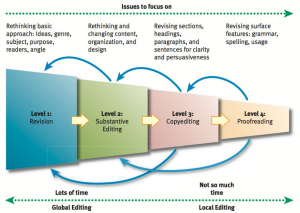There was a time when the title “Editor,” at least in terms of writing, had to be further clarified. Substantive Editor? Copyeditor? Proofreader? These were the days when editing killed a lot of trees and men stuck press credential in their hats.
Ok, perhaps not that long ago, but it does seem that way sometimes. With the advent of online content management, blog accessibility, and digital publishing, “editing” can be a catchall term covering an amalgam of skills. As a professional writer hiring an editor, you need to clarify what sort of expertise you’re getting. This has consequences for the student writer as well. If you’re faced with writing and revising a term paper, you’re going to want to approach revision as though you are wearing multiple hats, rather than covering all your editing bases in one pass.
I use the following graphic with my composition students. It’s a good representation of how the editing process can be segmented for maximum effectiveness.

There are four basic phases:
- Revision
- Substantive Editing
- Copyediting
- Proofreading
I’ll cover Revision and Substantive Editing in my next post, so let’s look at Copyediting and Proofreading for now. While the temptation may be great to do both in one pass, the distinction is necessary, especially if you operate under the “Work Smarter, Not Harder” mantra. Think of copyediting as clarifying the voice of your paper–how the sections and paragraphs come together to represent your ideas. A copyeditor wants to make sure the paper’s readability is maximized. Focus on clarity and consistency. Proofreading, on the other hand, about clarifying the look of your paper–typos, grammar mistakes, basic stuff. That should come as the absolute last step, when you know your content and flow are solid, and you just need to put that final inspection to be sure you don’t do something stupid, e.g. confuse there, their, and they’re.
Most content also appears on my LinkedIn page.